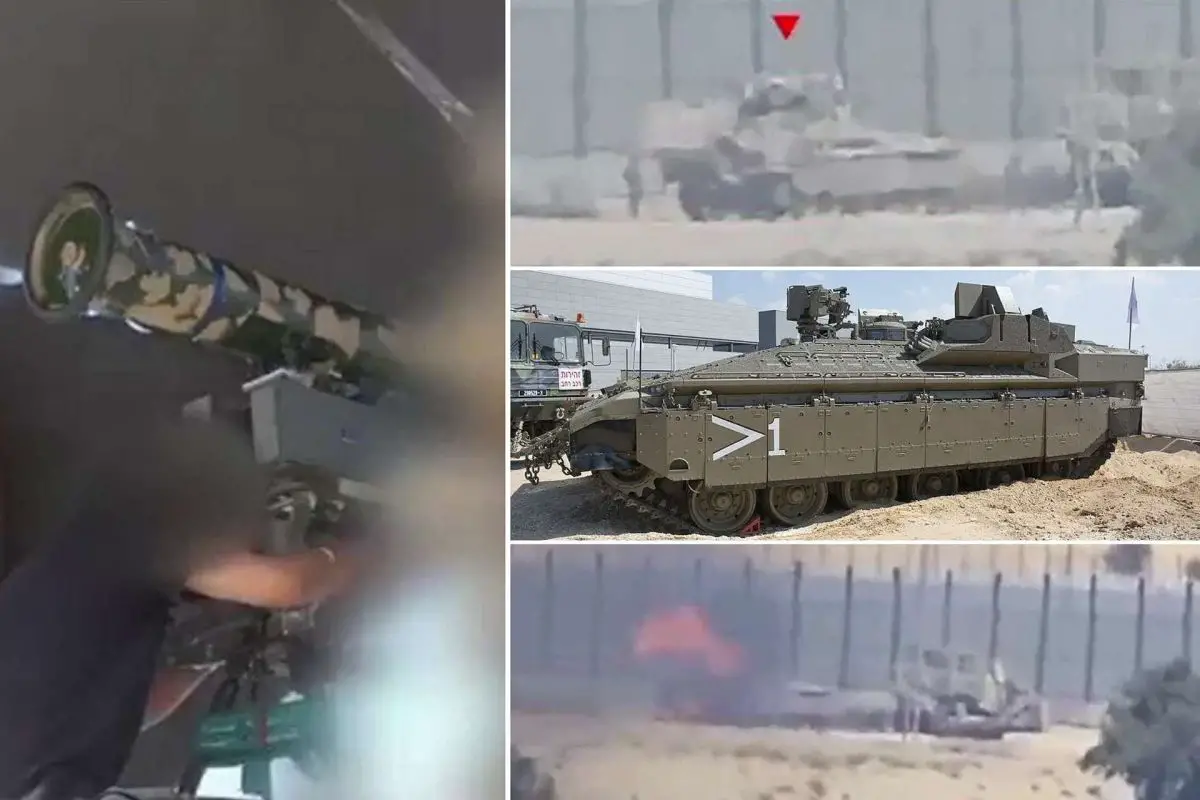Breaking News
Hamas uses Chinese HJ-8L missiles to destroy Israeli Namer Handasa heavy engineering vehicle.
As reported by War Noir on June 24, 2024, members of the Al-Qassam Brigades, the military wing of Hamas, destroyed a Namer Handasa heavy engineering vehicle belonging to the Israel Defense Forces' (IDF) Combat Engineering Corps in Rafah, Gaza Strip. The attack was carried out using the HJ-8L, a variant of China's HJ-8 anti-tank guided missile, designed to be lighter and more easily transportable while retaining the same anti-armor capabilities.
Follow Army Recognition on Google News at this link

The attack against the Namer Handasa heavy engineering vehicle was carried out using the HJ-8L, a variant of China's HJ-8 anti-tank guided missile, designed to be lighter and more easily transportable while retaining the same anti-armor capabilities. (Picture source: Twitter/War Noir and Wikimedia)
The HJ-8, or Hongjian-8, is a second-generation, tube-launched, optically tracked, wire-guided anti-tank missile system developed by China. Development began in 1970 when China's armored corps sought a replacement for the HJ-73. Designated as AFT-8 or HJ-8, the project experienced delays due to political issues but resumed after the Cultural Revolution, completing in the early 1980s. Designed by Wang Xingzhi and Zhao Jiazheng, the missile entered mass production in 1984 after receiving state certification. The HJ-8 has been in service since 1985 and is produced by NORINCO's factories and GIDS in Pakistan. It has been used in conflicts such as the Yugoslav wars, the Sri Lankan Civil War, and the Syrian Civil War.
The HJ-8 series is China's first domestically developed anti-tank missile system, influenced by Western systems like the US BGM-71 TOW, French/German MILAN, and UK Swingfire. It features a HEAT warhead capable of penetrating 800–1100 mm of RHA, with models like the HJ-8E offering a range of up to 4,000 meters and the capability to defeat explosive reactive armor (ERA). The HJ-8 can be deployed from tripods, vehicles, and aircraft, and is used as the anti-tank weapon for several PLA helicopter gunships, including the Z-9W and Mi-17.
The HJ-8L variant was developed to meet the need for a lighter anti-tank missile system, based on combat experiences in the Bosnian War. The HJ-8L, weighing 22.5 kg due to the use of composite materials and advanced microelectronics, can be equipped with two missile types: a smaller one with a 3 km range and a larger one with a 4 km range. This variant can be carried by a crew of two, offering flexibility in various combat scenarios while maintaining the system's capabilities.

The HJ-8L variant was developed to meet the need for a lighter anti-tank missile system, based on combat experiences in the Bosnian War. (Picture source: Wikimedia)
The Namer Handasa ("Engineering Namer"), also referred to as "Namer E," is a heavily armored combat engineering vehicle developed and manufactured in Israel. It serves as a specialized version of the Merkava-based Namer armored personnel carrier (APC), designed to function as an engineering and heavy sapper APC. The Namer E was introduced into the Israel Defense Forces' (IDF) Combat Engineering Corps in late 2016, replacing the older Puma APC.
The Namer E is based on the standard Namer heavy APC platform but includes several modifications for its engineering role. Since the Namer E is intended to support Merkava tanks at the front lines, it features enhanced armor and the Trophy active protection system (APS). It includes a remote-controlled weapon station, typically armed with a .50 caliber M2 Browning heavy machine gun, and a digital battle management system integrated with the IDF's C4I network.
The Namer Handasa is equipped with a range of engineering tools and attachments that can be installed as needed. These include bulldozer blades, plows, bridging equipment, minefield breaching systems like the Tzefa Shiryon, Carpet rocket mine-clearing system, jammers, and electromagnetic IED detectors. Additionally, classified engineering systems and equipment are stored on the vehicle's roof for use by sappers. The vehicle's design also accommodates ten sappers, with entry through a rear door, similar to APCs like the Achzarit and M113, unlike the front entry of the Puma and Centurion-based APCs.

The development of the Namer E began in 2011, with a prototype entering trial service with the 605th Battalion of the Combat Engineering Corps by the end of that year. (Picture source: Wikimedia)
The Namer E is built in three basic configurations: a company commander's vehicle with a bulldozer blade, a platoon commander's vehicle with breaching tools such as the Nokri plow, and a platoon sergeant's vehicle with bridging equipment.
The development of the Namer E began in 2011, with a prototype entering trial service with the 605th Battalion of the Combat Engineering Corps by the end of that year. The development of the operational model was completed in 2016, and it entered service with the Combat Engineering Corps' 603rd Battalion ("Lehav") in late 2016. In 2021, the 601st Battalion ("Asaf") was converted to use the Namer E.
The Namer E participated in the ground maneuver in the Gaza Strip during Operation Swords of Iron. On June 15, 2024, during operations in the Tel al-Sultan area of Rafah, a Namer E from the 601st Battalion of the Combat Engineering Corps was hit by either a belly charge or an anti-tank missile fired by Hamas, resulting in the deaths of eight soldiers.
This heavily armored vehicle measures 8.2 meters in length, 3.92 meters in width, and approximately 2.5 meters in height, including the machine gun station. It weighs 63.5 tons and can reach a maximum speed of 53 km/h with a range of 500 kilometers. It is powered by a 1,200-horsepower diesel engine and is equipped with both passive and reactive armor in addition to the Trophy active protection system. The crew consists of three personnel plus ten combat engineers. Its primary armament includes a remote-controlled weapon station with a .50 caliber Browning heavy machine gun and rocket clearing systems, while secondary armaments consist of a 7.62 mm MAG machine gun, smoke launchers, and a 60 mm mortar.


























